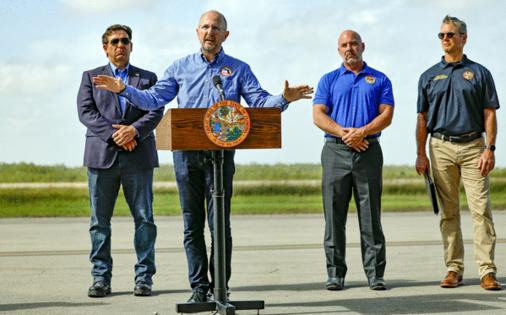Florida has no formal hurricane plan for Alligator Alcatraz
Published in News & Features
MIAMI — After weeks of requests from politicians and media, the state of Florida said it has no formal, completed plan for how to handle a hurricane at Alligator Alcatraz, the new immigrant detention site in the heart of the Everglades.
Two weeks ago, the Miami Herald requested “the completed hurricane/disaster plan for Alligator Alcatraz” from the Florida Department of Emergency Management. On Monday, department spokesperson Stephanie Hartman confirmed that no such record exists.
“There are no responsive records for this request,” she said in an email.
This comes after a Friday press conference at the detention facility, where Gov. Ron DeSantis and FDEM head Kevin Guthrie issued a hearty defense of the state’s ability to protect staff and detainees in the event of a disaster. Guthrie said his team had visited several prisons around the state to explore options for evacuating detainees there, but didn’t commit to any specific plan.
The governor has repeatedly said the tents and trailers at the site are equipped to handle hurricane winds to Category 2 strength — up to 110 mph — and that people onsite would have to be evacuated if more intense winds were expected. The facility already relies on generators for on-site power.
Neither Guthrie nor the governor mentioned anythign about flood risks at the site, which already had water seeping into the air conditioned tents where detainees are housed after a particularly heavy rainstorm on opening day.
“I promise you that the hurricane guys have got the hurricane stuff covered,” Guthrie said.
The lack of formal plans worries the facility’s nearest neighbors, the Miccosukee Tribe, which wants to join a lawsuit to close Alcatraz on environmental grounds. Curtis Osceola, senior executive policy adviser for the Miccosukee Tribe, called the lack of plan “reckless.”
The tribe’s housing, which surrounds the site, is made of rebar-reinforced concrete. It has “extensive emergency management and evacuation plans,” including a shelter for tribal members in the strongest building in their complex. The hurricane plan is refreshed every year, Osceola said.
Flooding is a perpetual issue during storms, he said. After Hurricane Irma dropped almost two feet of water on Big Cypress in 2017, the tribe needed pumps to keep the village dry, he said. Gladesmen in the area have reported that during particularly heavy rainstorms, even outside of hurricanes, rain can pile up and inundate the runway on the site, he said.
“If there are no plans, it certainly puts lives at risk during one of the most dangerous and unpredictable times of year for Florida,” he said. “Everything about this just shows how poorly planned this was, and now that we’re seeing there’s no hurricane plan, it’s proof positive that this was not thought through beyond making headlines.”
_______
©2025 Miami Herald. Visit miamiherald.com. Distributed by Tribune Content Agency, LLC.







Comments